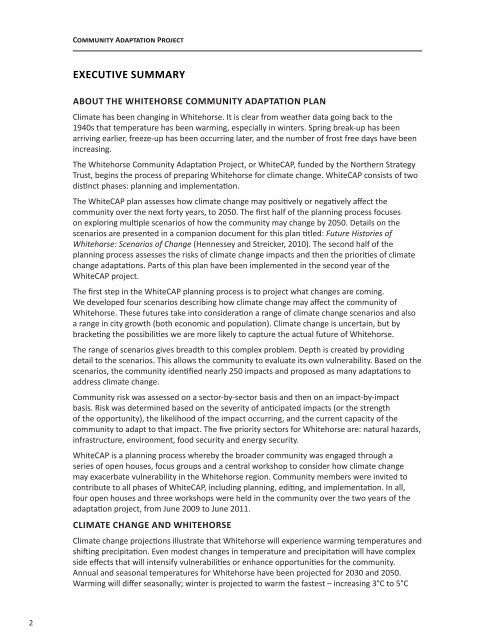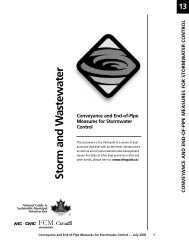Whitehorse Climate Change Adaptation Plan - Yukon College
Whitehorse Climate Change Adaptation Plan - Yukon College
Whitehorse Climate Change Adaptation Plan - Yukon College
Create successful ePaper yourself
Turn your PDF publications into a flip-book with our unique Google optimized e-Paper software.
2<br />
Community <strong>Adaptation</strong> Project<br />
EXECUTIVE SUMMARY<br />
ABOUT THE WHITEHORSE COMMUNITY ADAPTATION PLAN<br />
<strong>Climate</strong> has been changing in <strong>Whitehorse</strong>. It is clear from weather data going back to the<br />
1940s that temperature has been warming, especially in winters. Spring break-up has been<br />
arriving earlier, freeze-up has been occurring later, and the number of frost free days have been<br />
increasing.<br />
The <strong>Whitehorse</strong> Community <strong>Adaptation</strong> Project, or WhiteCAP, funded by the Northern Strategy<br />
Trust, begins the process of preparing <strong>Whitehorse</strong> for climate change. WhiteCAP consists of two<br />
distinct phases: planning and implementation.<br />
The WhiteCAP plan assesses how climate change may positively or negatively affect the<br />
community over the next forty years, to 2050. The first half of the planning process focuses<br />
on exploring multiple scenarios of how the community may change by 2050. Details on the<br />
scenarios are presented in a companion document for this plan titled: Future Histories of<br />
<strong>Whitehorse</strong>: Scenarios of <strong>Change</strong> (Hennessey and Streicker, 2010). The second half of the<br />
planning process assesses the risks of climate change impacts and then the priorities of climate<br />
change adaptations. Parts of this plan have been implemented in the second year of the<br />
WhiteCAP project.<br />
The first step in the WhiteCAP planning process is to project what changes are coming.<br />
We developed four scenarios describing how climate change may affect the community of<br />
<strong>Whitehorse</strong>. These futures take into consideration a range of climate change scenarios and also<br />
a range in city growth (both economic and population). <strong>Climate</strong> change is uncertain, but by<br />
bracketing the possibilities we are more likely to capture the actual future of <strong>Whitehorse</strong>.<br />
The range of scenarios gives breadth to this complex problem. Depth is created by providing<br />
detail to the scenarios. This allows the community to evaluate its own vulnerability. Based on the<br />
scenarios, the community identified nearly 250 impacts and proposed as many adaptations to<br />
address climate change.<br />
Community risk was assessed on a sector-by-sector basis and then on an impact-by-impact<br />
basis. Risk was determined based on the severity of anticipated impacts (or the strength<br />
of the opportunity), the likelihood of the impact occurring, and the current capacity of the<br />
community to adapt to that impact. The five priority sectors for <strong>Whitehorse</strong> are: natural hazards,<br />
infrastructure, environment, food security and energy security.<br />
WhiteCAP is a planning process whereby the broader community was engaged through a<br />
series of open houses, focus groups and a central workshop to consider how climate change<br />
may exacerbate vulnerability in the <strong>Whitehorse</strong> region. Community members were invited to<br />
contribute to all phases of WhiteCAP, including planning, editing, and implementation. In all,<br />
four open houses and three workshops were held in the community over the two years of the<br />
adaptation project, from June 2009 to June 2011.<br />
CLIMATE CHANGE AND WHITEHORSE<br />
<strong>Climate</strong> change projections illustrate that <strong>Whitehorse</strong> will experience warming temperatures and<br />
shifting precipitation. Even modest changes in temperature and precipitation will have complex<br />
side effects that will intensify vulnerabilities or enhance opportunities for the community.<br />
Annual and seasonal temperatures for <strong>Whitehorse</strong> have been projected for 2030 and 2050.<br />
Warming will differ seasonally; winter is projected to warm the fastest – increasing 3°C to 5°C

















